June 7, 2025 | 02:58 GMT +7
June 7, 2025 | 02:58 GMT +7
Hotline: 0913.378.918
June 7, 2025 | 02:58 GMT +7
Hotline: 0913.378.918
Mr. Nguyen Van Gioi, a farmer in Ham Ninh commune (Quang Ninh district, Quang Binh province), brought us to his soon-to-bloom rice fields excitedly: “For several years, I have followed Uncle Minh in producing organic rice. Every year, with this production method, I save about 15 million VND/ha.”

Model of organic rice with high yield in Ham Ninh field. Photo: Thanh Nga.
According to Mr. Ha Xuan Hung, Chairman of Ham Ninh Commune People's Committee, this land is likened to a "death zone" because of the lack of water for production and daily life. The entire commune has over 370ha of rice area, so only one crop can be grown and left to chances. After the construction of Rao Da reservoir and water is restored, farmers could finally grow two guaranteed crops.
However, by now, most farmers still follow the old cultivation methods. “That means sowing at the rate of 7-10kg of seed/sao (500m2). Still using inorganic fertilizers and spraying pesticides. We are organizing new models, encouraging farmers to apply saving in production and increasing efficiency per unit area" said Mr. Ha Xuan Hung.
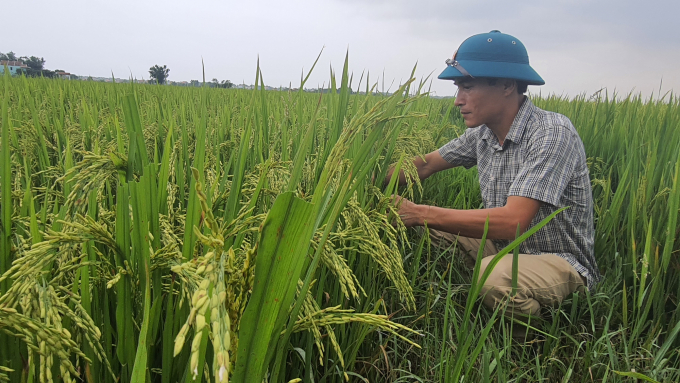
Organically produced rice fields are the highlight to improve the fields for high-yielding crops. Photo: Thanh Nga.
According to Mr. Gioi's calculation, currently, farmers cultivating following traditional methods have to spend about 800 - 900 thousand VND/sao (16 - 18 million VND/ha). “These are 3 expenses, including seeds (about 280,000 VND), fertilizers (12kg of nitrogen, 15kg of NPK, at about 460-500,000 VND), pesticides (about 3-4 sprayings, at about 100,000 VND). This is a low fixed cost. And if the prices of varieties and fertilizers go up and the crops suffer from many pests and diseases, the cost will increase even more," said Mr. Gioi.
Mr. Nguyen Le Minh, Deputy Director of Indochina Green Food Joint Stock Company (Quang Binh) once passed by Ham Hoa field (Ham Ninh commune) and saw in the vast, flat field, many farmers busy spraying herbicides. The unpleasant smell of the chemicals spread in the morning wind. Mr. Minh asked Mr. Gioi to stop and then pulled him aside to talk. “I want to hire you to grow rice for me. Organic rice production. Is it okay?”, Mr. Minh questioned frankly.
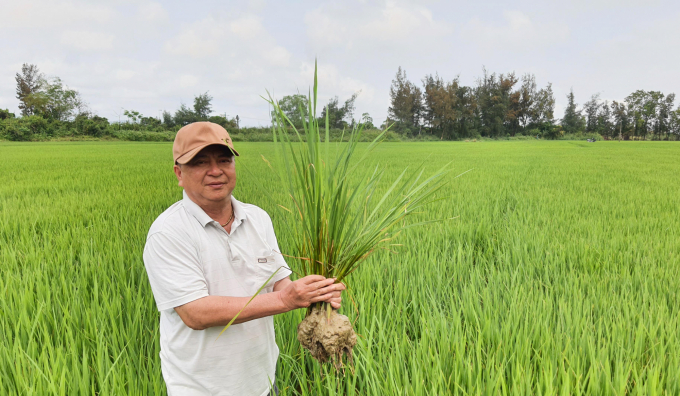
Mr. Nguyen Van Gioi: "Through two crops of organic production, rice plants grow well, saving costs in the field...". Photo: Thanh Nga.
At first, upon hearing a stranger saying something he had not thought of, Mr. Gioi immediately refused. "I've worked in the fields normally for most of my life. I'm turning 70 this year" said Mr. Gioi. Undeterred, Mr. Minh said, "It's alright if you can't do it for me. But lease the field to me, I will pay more than your yield of rice. Money can be taken immediately or after the rice is harvested", Mr. Minh said. Not having to work hard for a high income, Mr. Gioi agreed with the contract: "If Mr. Minh can succeed, next year Mr. Gioi will put all the area into organic rice production so farmers can follow and study". That rice crop, Mr. Minh won. Although the selected field is arid land with little water because it lies at the end of the irrigation source, the rice yield is equal to that of the "first-class" field. That was 3 years ago…
By now, Mr. Nguyen Van Gioi has implemented the organic rice model on a 2-crop rice field with an area of about 10 hectares.
"First of all, the reduction in seeds", Mr. Gioi continued the story. Instead of sowing 8-10 kg/sao like farmers usually do, he only sowed 5 kg/sao, even after putting the transplanter in with only 3 kg/sao left. Initially, the rice plants growing in the field looked very unpromising because only the color of the soil was brown and black, not green. “But when the rice plants take root firmly, with an amount of organic fertilizer,they grow very rapidly. The rate of tillering and greening in the field exceeds that of thickly sown rice. “In the first crops, we reduced the cost of 3 expenses to about 1.1 million VND/sao (3 million VND/ha/crop). Besides, sowing thinly also helps reduce the effort of trimming," added Mr. Gioi.
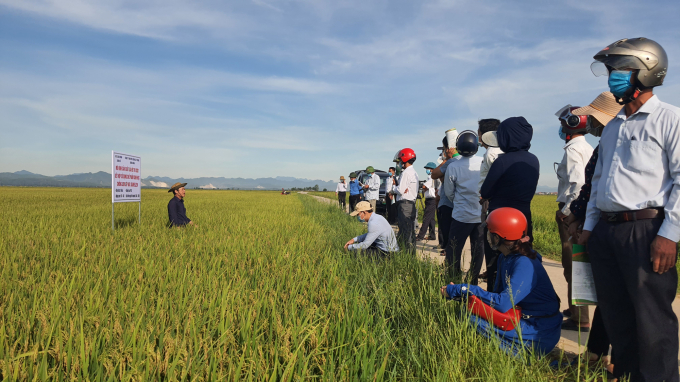
Farmers in the area visiting the organic rice production model. Photo: Thanh Nga.
After the first two crops of organic rice, the cost reduction has not clearly shown, but the rice sold on the market has increased markedly. By the third crop, the cost was reduced significantly. The field has undergone two organic fertilizer seasons, so nutritions have improved. At this time, in Mr. Gioi's field, he only used 30kg of organic fertilizer/sao and 12kg of nitrogen fertilizer. The fertilizers used are Biooptima 1 and Biooptima 2 (produced by Tien Dong Investment Joint Stock Company). "In the production process, we only use biological pesticides, not chemicals," said Mr. Gioi.
On the day of harvest, many farmers in the area came to watch and learn. Everyone complimented the sturdy rice plant, the long and firm rice grain, even though the field where the model was carried out belonged to infertile soil. The model rice yield is about 60 quintals/ha. Meanwhile, the average yield of rice produced using local inorganic fertilizers is only 55 quintals/ha. “Excluding the high selling price, by reducing in 3 expenses, I could save about 300-400 thousand VND/sao. That means saving from 12 to 16 million VND/ha for two crops of rice", Mr. Gioi acknowledged.
Also on an area of 2ha, Mr. Gioi combines shrimp and crab stocking to increase production efficiency. Mr. Gioi said that in addition to stocked shrimp, there are also natural shrimp varieties. Because only organic fertilizers are used, a good environment is maintained for shrimps to thrive. Surrounding the rice area is a ditch system with a water depth of about one meter. When the rice is in the field is close to blooming, Mr. Gioi releases the rattan (a tool used to catch crayfish). At the end of the afternoon, the rattan is released into the ditch. Overnight, the crayfish swim in to eat and get stuck in the trap. In the morning, the rattan is pulled up and the shrimps are sold to traders. "The income from shrimp and crab farming also adds several tens of millions of dong/ha," said Mr. Gioi.
When the field of Ham Hoa village was in its third crop, Mr. Minh went to the fields of Hoanh Vinh village (An Ninh commune, Quang Ninh district) to organize a model of 5 hectares in the poor nutrition field. Mr. Tran Thanh Hai, Director of Quang Binh Agriculture and Aquaculture Extension Center, said that when implementing the model, we chose poor soil to apply organic fertilizers. Just after 3 rice crops, the nutrients in the soil increase by a lot and for the next crop, the yield will be high and stable.
Due to poor soil quality, the yield for DT18 rice variety in the model is only nearly 50 quintals/ha. Mr. Vo Doan Duc, Director of Hoanh Vinh Agricultural Service Cooperative (the unit implementing the model) acknowledged that such productivity on poor land is a good sign. Farmers who observe this model are very excited. The yield of rice is not inferior and also ensures the health of everyone. Daily meals are now without the risk of being contaminated with harmful drugs. “The savings of 3 expenses in the first crop alone is 3 million VND/ha. If we put it into mass production on an area of over 300 hectares on a large sample field, we will gain an additional profit of nearly VND billion. If 2 crops are grown a year, farmers will get an additional 2 billion VND in profit", Mr. Duc added.
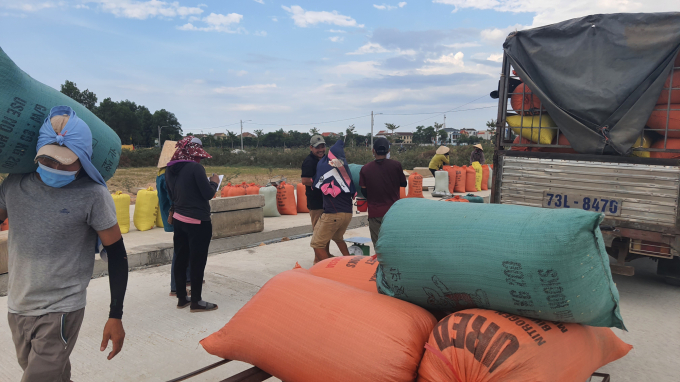
Rice cultivated following the organic model has a higher selling price compared to conventional rice, so farmers are excited. Photo: Thanh Nga.
In the following crop, Hoanh Vinh village expanded the organic farming area. “During the period of rising prices for plant protection drugs, fertilizer materials, farmers are encouraged to cultivate organically to reduce production costs, improve fields and improve the quality of rice grains, heading towards ensuring safety of the working and eating environment is the first aspect that needs to be prioritized," said Mr. Duc.
In the two areas where organic rice farming is implemented, the entire output is purchased by Indochina Company. The purchase price of single day sun-dried rice is at 9,000 VND/kg. Many farmers were excitedly that this was the highest selling price and with this price, farmers made a profit of 30-45 million VND/ha". We will continue to accompany the Provincial Agriculture and Aquaculture Extension Center to support farmers with increasingly high and stable incomes right on their own fields" - Mr. Nguyen Le Minh hoped.
Translated by Nguyen Hai Long
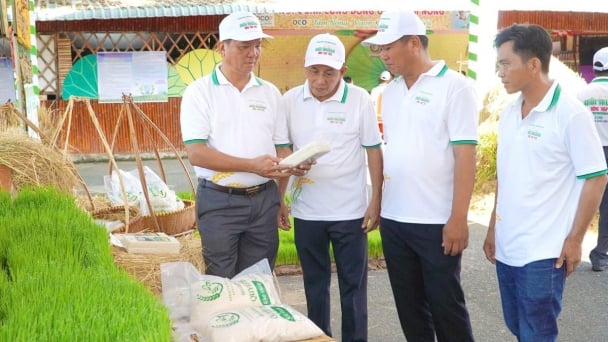
(VAN) Dong Thap has launched a meeting in response to the Action Month for the Environment under the theme 'Live Green - Join Hands for a Green Economy' at Tram Chim National Park.
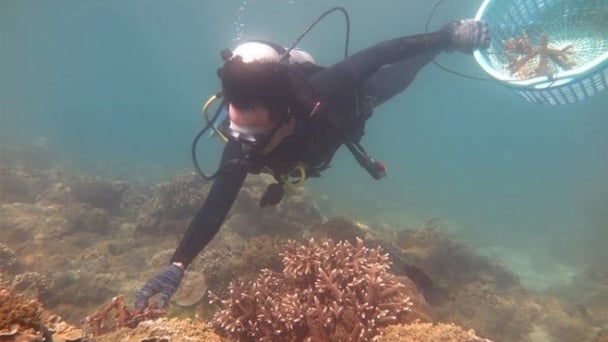
(VAN) The ocean has the capacity to absorb millions of tons of carbon, provided that mangrove forests, coral reefs, and biodiversity are protected.
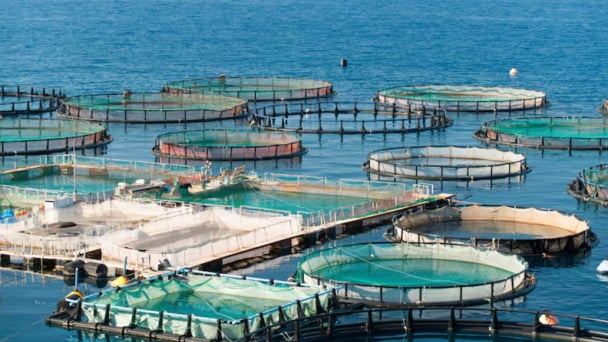
(VAN) Technology is redrawing the map of Vietnamese aquaculture: more modern, greener, and more sustainable.
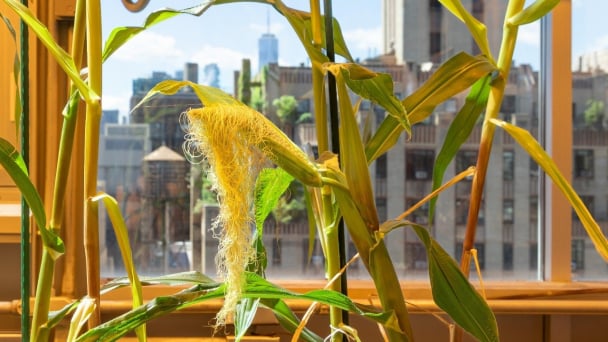
(VAN) Novel process harnesses machine learning to reveal groups of genes that determine how efficiently plants use nitrogen.

(VAN) Several scientists and farmers are experimenting with soil treatment in some key durian-growing regions such as Cai Lay (Tien Giang), Dak Song, Gia Nghia, and Dak R’lap (Dak Nong).
/2025/05/25/4127-3-073637_820.jpg)
(VAN) Thanks to the promotion from an FAO-implemented project, vegetable production in greenhouses in Moc Chau has seen strong development, from 1.5 hectares in 2021 to nearly 50 hectares in 2024.

(VAN) FAO has recently supported USD 140,000 to implement the project 'Risk mitigation human-animal interface risks through disease control initiatives in pig farming.'